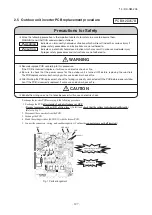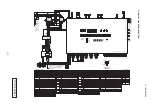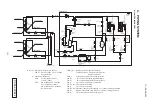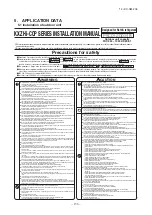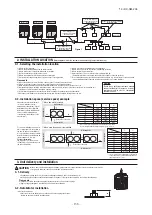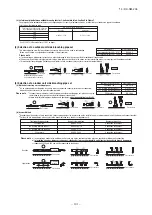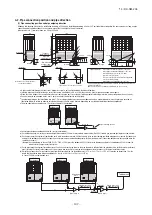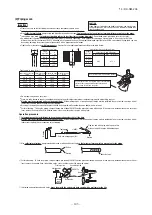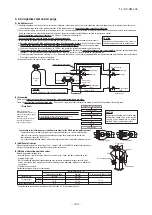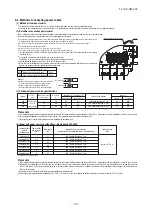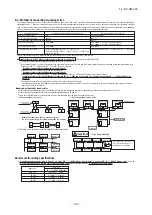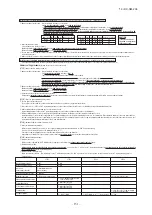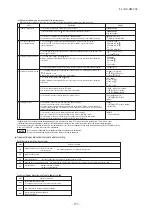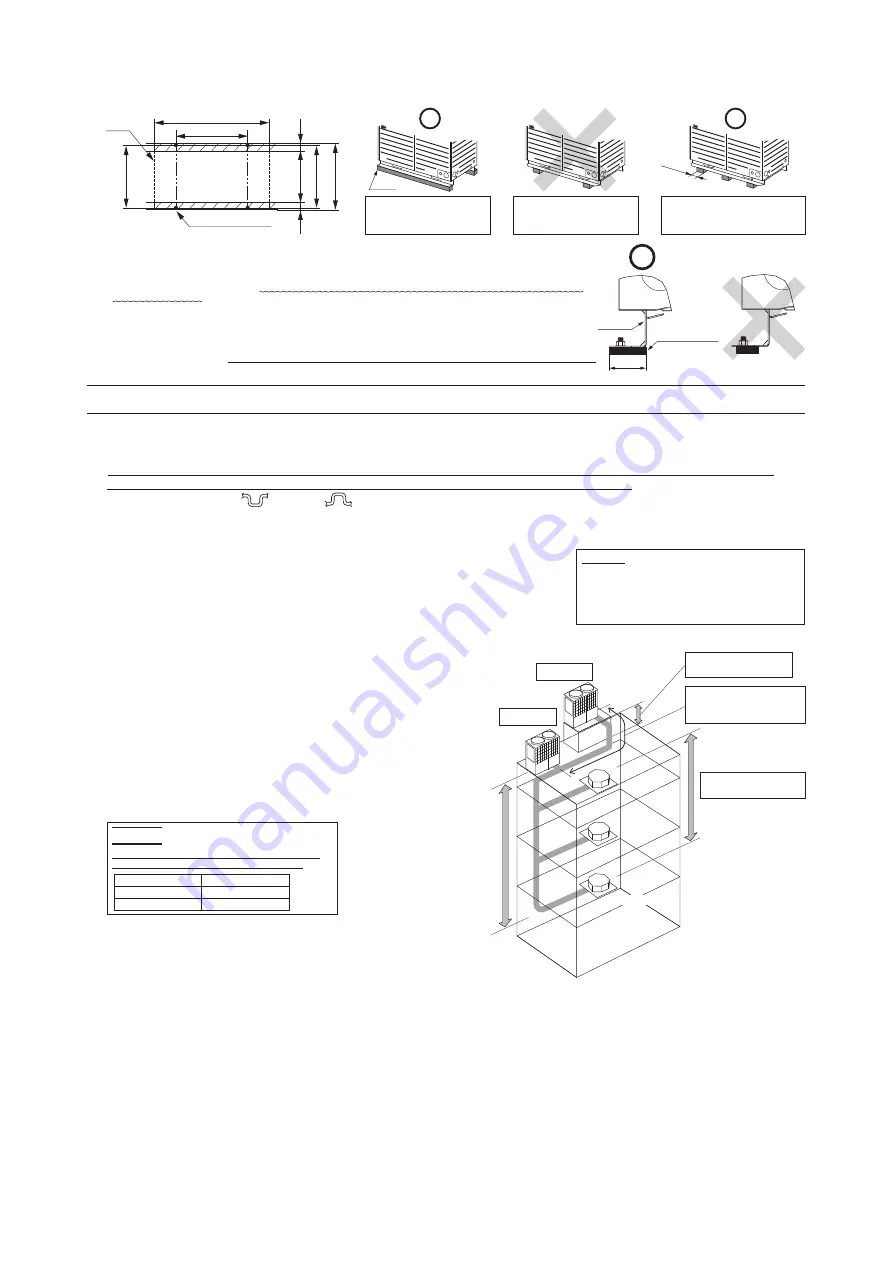
-
139
-
'14 • KX-SM-204
720
764
726
594
85
85
850
1350
Anchor bolt positions
(
●
mark)
Unit
20
Over
100
mm
Normally, it is desirable that a
base as specified in the drawing
above is provided.
A base used for a former model
is wrongly oriented and not
acceptable.
Please use it for renewal installation.
(Please add a base on the center)
It is necessary to prevent sagging.
Base
Unit leg
Vibration
isolating rubber
85
Outdoor unit
Outdoor unit
Height difference between
outdoor units 0.4m
Height difference between
indoor units 18m
Distance between an outdoor
unit and an outdoor unit side
branching pipe 5m
Difference in the elevation 50m
(Max 70m)
Actual length
160m
Equivalent length
185m
Total length
1000m
Indoor unit
Figure 1
Indoor unit
Indoor unit
Outdoor unit
Outdoor unit
Outdoor unit
Branching pipe set
on the indoor unit side
Model type: DIS
Branching pipe set
on the outdoor unit side
Model type: DOS
Branching pipe set
on the indoor unit side
Model type: DIS
Header set on the indoor unit side
Model type: HEAD
E
A
A
B
C
C
C
C
D
D
D
D
D
D
D
D
A
A
CAUTION
An installation not conforming to these restrictions
can induce a compressor failure, which shall be
excluded from the scope of warranty. Always
observe the restrictions on the use of pipes in
developing a system.
CAUTION
Please leave sufficient clearance around
the unit without fail. Otherwise, a risk of
compressor and/or electric component
failure may arise.
MITSUBISHI HEAVY INDUSTRIES, LTD.
MULTI AIR CONDITIONER OUTDOOR UNIT FOR BUILDINGS
KXZ Hi-COP SERIES INSTALLATION MANUAL
Notabilia as a unit designed for R410A
a)
b)
c)
d)
e)
f)
g)
h)
Gauge manifold
Charge hose
Electronic scale for refrigerant charging
Torque wrench
Flare tool
Protrusion control copper pipe gauge
Vacuum pump adapter
Gas leak detector
Dedicated R410A tools
CAUTION
ACCESSORY
●
Please read this manual without fail before you set to installation work and carry it out according to this manual.
●
For the installation of an indoor unit, please refer to the installation manual of an indoor unit.
●
For piping work, option distribution parts (branching pipe set, header set) are necessary. Please refer to our catalog, etc.
●
Never fail to install an earth leakage breaker. (Please use one tolerable to harmonic components)
●
Operating the unit with the outlet pipe thermistor, the inlet pipe thermistor, the pressure sensor, etc. removed can result in a compressor burnout. Avoid operation
under such conditions in any circumstances.
●
With this air-conditioning system, room temperature may rise, depending on installation conditions, while indoor units are stopped, because small quantity of
refrigerant flows into the stopped indoor units if heating operation is conducted on the system.
COMBINATION PATTERNS
The same outdoor unit is used whether it is used alone or in combination with another unit.
●
Please note that an installation involving a combination other than those listed below is not operable. (For example, you cannot operate 280 and 400 in combination)
●
The possible outdoor unit combinations and the number and the total capacity of indoor units that can be connected in a system are shown in the table below.
●
Please always use indoor units designed exclusively for R410A. For connectable indoor unit model names, please check with our catalog, etc.
●
It can be used in combination with the following indoor unit.
【
Option parts
】
Refrigerant distribution piping components supplied as optional parts will become necessary in installing the unit.
As refrigerant distribution piping components, branching pipe sets (model type: DOS) for the outdoor unit side piping, branching pipe sets (model type: DIS) and
header sets (model type: HEAD) for the outdoor unit side piping are available.
Select according to the application. Please refer to "4. Refrigerant piping work" in selecting.
If you are uncertain, please do not hesitate to consult with your distributor or the manufacturer.
Please use refrigerant branching sets and header sets designed exclusively for R410A without fail.
Name
Wiring
Quantity
2
1
Usage location
In operating the unit in the silent mode or the forced cooling/heating mode,
insert it to the outdoor unit board
'
s CNG.
It is supplied with the unit. You can find
it taped inside the control box.
Instruction manual
When the installation work is completed,
give instructions to the customer and ask him/her to keep it.
Attached on the side panel below the
operation valve.
Capacity
224
280
335
450
500
560
615
670
735
800
850
900
950
1000
Combination patterns
Single
Single
Single
Combination
(
224+224
)
Combination
(
224+280
)
Combination
(
280+280
)
Combination
(
280+335
)
Combination
(
335+335
)
Combination
(
224+224+280
)
Combination
(
224+280+280
)
Combination
(
280+280+280
)
Combination
(
280+280+335
)
Combination
(
280+335+335
)
Combination
(
335+335+335
)
Number of connectable units (units)
1
-
29
1
-
37
1
-
44
2
-
60
2
-
53
2
-
59
2
-
65
2
-
71
3
-
78
3
-
80
3
-
80
3
-
80
3
-
80
3
-
80
Range of the total capacity of indoor units connected in a system
180
-
448
224
-
560
268
-
670
360
-
900
400
-
800
448
-
896
492
-
984
536
-
1072
588
-
1176
640
-
1280
680
-
1360
720
-
1440
760
-
1520
800
-
1600
Indoor unit
Outdoor unit
◎
This installation manual deals with outdoor units and general installation specifications only. For indoor units, please refer to the respective installation manuals
supplied with your units.
◎
Please read this manual carefully before you set to installation work and carry it out according to the instructions contained in this manual.
Designed for R410A refrigerant
●
By defining a cartage path, carry in the entire package containing a unit to its installation point.
●
In slinging a unit, use two canvas belts with plates, cloth pads or other protections applied to the unit to prevent damage.
Please note
a) Please do not fail to put belts through the rectangular holes of a unit
'
s anchoring legs.
b) Apply cloth pads between a canvas belt and a unit to prevent damage.
When a unit is hoisted with slings for haulage, please take into consideration the offset of its gravity center position.
If not properly balanced, the unit can be thrown off-balance and fall.
Please note
a) A four-sided enclosure cannot be used. Leave a space of at least 1m above the unit.
b) If there is a danger of a short-circuit, then install a wind direction variable adapter.
c) When installing multiple units, provide sufficient intake space so that a short-circuit does not occur.
d) In areas where there is snowfall, install the unit in a frame or under a snow hood to prevent snow from accumulating on it.
(Inhibition of collective drain discharge in a snowy country)
e) Do not install the equipment in areas where there is a danger for potential explosive atmosphere.
* Please ask your distributor about optional parts such as wind vane adapters, snow guard hoods, etc.
2.
INSTALLATION LOCATION
(Obtain approval from the customer when selecting the installation area.)
〇
Where air is not trapped.
〇
Where the installation fittings can be firmly installed.
〇
Where wind does not hinder the intake and outlet pipes.
〇
Out of the heat range of other heat sources.
〇
Where strong winds will not blow against the outlet pipe.
〇
A place where stringent regulation of electric noises is not applicable.
〇
Where it is safe for the drain water to be discharged.
〇
Where noise and hot air will not bother neighboring residents.
〇
Where snow will not accumulate.
〇
A place where no TV set or radio receiver is placed within 5m.
(If electrical interference is caused, seek a place less likely to cause the problem)
〇
Do not install the unit in places which exposed to sea breeze (e.g. coastal area) or calcium chloride
(e.g. snow melting agent), exposed to ammonia substance (e.g. organic fertilizer).
2-1. Selecting the installation location
Please secure sufficient clearance
(room for maintenance work,
passage, draft and piping). (If your
installation site does not fulfill the
installation condition requirements
set out on this drawing, please
consult with your distributor or the
manufacturer)
2-2. Installation space (service space) example
(2) Base
●
Please install a unit after ascertaining that the bases have been made to sufficient strength and level to ensure the unit against
vibration or noise generation.
●
Please construct a base to the size of a shadowed area (the entire bottom area of an outdoor unit
'
s anchoring leg) shown on the
above drawing or larger.
●
Please orient a base in the traversal direction (direction of W1350mm) of an outdoor unit as illustrated in the drawing above.
(3) Vibration isolating rubber
●
A vibration isolating rubber must support an outdoor unit
'
s anchoring leg by its entire bottom area.
Please note
1) Install a vibration isolating rubber
in such a manner that the entire bottom area of an outdoor unit’s anchoring leg will rest on it
.
2) Do not install an outdoor unit in such a manner that a part of the bottom area of its anchoring leg is off a vibration isolating rubber.
3-1. Delivery
①
When one unit is installed
②
When more than one unit are installed
L3
Wall height H2
Wall height H4
Wall height H1
(Front side of the unit)
Wall height H3
L1
L2
L4
L3
Wall height H2
Wall height H4
Wall height H1
(Front side of the unit)
Wall height H3
L1
L2
L4
L6
L5
Ⅲ
Open
10 (30)
100
Open
Open
No limit
No limit
Open
Ⅱ
500
50
50
50
1500
No limit
1000
No limit
Ⅰ
500
10 (30)
100
10 (30)
1500
No limit
1000
No limit
L1
L2
L3
L4
H1
H2
H3
H4
Dimensions
Example installation
Ⅱ
Open
200
300
Open
400
400
Open
No limit
No limit
Open
Ⅰ
500
10 (30)
100
10 (30)
10 (30)
10 (30)
1500
No limit
1000
No limit
L1
L2
L3
L4
L5
L6
H1
H2
H3
H4
Dimensions
Example installation
(1) Anchor bolt positions
●
Use four anchor bolts (M10) to fix an outdoor unit's anchoring legs at all times.
Ideally, an anchor bolt should protrude 20mm.
3-2. Notabilia for installation
4. REFRIGERANT PIPING
●
In installing pipes, always observe the restrictions on the use of pipes specified in this Section (1) including Maximum length, Total pipe
length, Allowable pipe length from the first branching, and Allowable elevation difference (head difference)
.
●
Please avoid forming any trap ( ) or bump ( ) in piping as they can cause fluid stagnation.
●
Maximum length (from an outdoor unit to the farthest indoor unit)
・・・・・・・・・
160 m or less as actual pipe length (185 m or less as equivalent pipe length)
(When an actual pipe length exceeds 90m, however, it is necessary to change the pipe size. Please determine the main pipe size by consulting with the Main
Selection Reference Table set out in Section (3) (b).
●
Total pipe length
・・・・・・・・・・・・・・・・・・・・・・・・・・・・・・・・・・・・・・・・・・・・・・・・・・・・・・・・・・・・・
1000 m or less
●
Main pipe length
・・・・・・・・・・・・・・・・・・・・・・・・・・・・・・・・・・・・・・・・・・・・・・・・・・・・・・・・・・・・・
130 m or less
●
Allowable pipe length from the first branching
・・・・・・・・・・・・・・・・・・・・・・・・・・・・・
90 m or less
(However, difference between the longest and shortest piping
・・・・・・・・・・・・
40 m or less (Max 85 m or less
※1
))
※
1
When it is required to install in a range of 40 to 85 m, limitation of use, etc. are different from those described here.
Refer to technical documents.
●
Allowable elevation difference (head difference)
(a) When an outdoor unit is installed above
・・・・・・・・・・・・・・・・・・・・・・・・・・・・・・・・・
50 m or less (Max 70 m or less)
※2
※
2
When it is required to install in a range of 50 to 70 m, limitation of use, etc. are different from those described here. Refer to technical documents.
(b) When an outdoor unit is installed below
・・・・・・・・・・・・・・・・・・・・・・・・・・・・・・・・・
40 m or less
※3
※
3
It must be less than 30 m when conducting the cooling operation with the outdoor air temperature lower than
10˚C.
(c) Difference in the elevation of indoor units in a system
・・・・・・・・・・・・・・・・・・
18 m or less
(d) Elevation difference between the first branching point and the
indoor unit
・・・・・・・・・・・・・・・・・・・・・・・・・・・・・・・・・・・・・・・・・・・・・・・・・・・・・・・・・・・・・・・・
18 m or less
●
Restrictions on piping applicable to the section between an
outdoor unit andan outdoor unit side branching pipe (combination unit)
(a) Difference in the elevation
・・・・・・・・・・・・・・・・・・・・・・・・・・・・・・・・・・・・・・・・・・・・・・・・
0.4 m or less
(b) Distance between an outdoor unit and an outdoor unit side branching pipe
・・・・
5 m or less
(c) Length of oil equalization piping
・・・・・・・・・・・・・・・・・・・・・・・・・・・・・・・・・・・・・・・・・
10 m or less
4-1. Restrictions on the use of pipes
●
Please use pipes clean on both the inside and outside and free from contaminants harmful to operation such as sulfur, oxides, dust, chips, oil, fat and water.
●
Use the following material for refrigerant piping.
Material: phosphorus deoxidized seamless copper pipe (C1120T-O, 1/2H, JIS H 3300)
Use C1220T-1/2H for
φ
19.05 or larger, or C1220T-O for
φ
15.88 or smaller
●
Do not use
φ
28.58 x t1.0,
φ
31.8 x t1.1,
φ
34.92 x t1.2 and
φ
38.1 x t1.35 as a bent pipe.
●
Thickness and size: Please select proper pipes according to the pipe size selection guideline.
(Since this unit uses R410A, always use 1/2H pipes of a specified minimum thickness or thicker for all pipes of
φ
19.05 or larger, because the pressure
resistance requirement is not satisfied with O-type pipes).
●
For branching pipes, use a genuine branching pipe set or header set at all times. (optional parts)
●
For the handling of operation valves, please refer to P.9 4-3(4) Method of operating operation valves.
●
In installing pipes, observe the restrictions on the use of pipes set out in Section 1 (Maximum length, total pipe length, allowable pipe length from the first
branching, allowable elevation difference (head difference)) without fail.
●
Install a branching pipe set, paying attention to the direction of attachment, after you have perused through the installation manual supplied with it.
(2) Piping material selection
3.
Unit delivery and installation
CAUTION
Precautions for safety
Never do it under any circumstances.
Always do it according to the instruction.
1. BEFORE BEGINNING INSTALLATION
(Check that the models, power source specifications, piping, wiring are correct.)
Indoor unit
Remote control
Connection OK/NO
FD○△△KXE6
RC-E3(2 cores), RC-E4(2 cores), RC-E5 (2 cores), RC-EX1A (2 cores)
OK
FD○A△△KXE4R, KXE4BR, KXE5R
RC-E1R(3 cores)
NO
FD○A△△KXE4, KXE4(A), KXE4A
RC-E1(3 cores)
NO
Notabilia
(1) Limitation on use of pipes
PSC012D031B
Outdoor unit capacity
FDC224–1000KXZXE1
●
Read these “Precautions for safty” carefully before starting installation work and do it in the proper way.
●
Safety instructions listed here are grouped into Warnings and Cautions. If a non-compliant installation method is likely to result in a serious consequence such as death
or major injury, the instruction is grouped into Warnings to emphasize its importance. However, a failure to observe a safety instruction listed under Cautions can also
result in a serious consequence depending on the circumstances. Please observe all these instructions, because they include important points concerning safety.
●
The meanings of “Marks” used here are as shown on the right:
●
When you have completed installation work, perform a test run and make sure that the installation is working properly. Then, explain the customer how to operate and how to take
care of the air-conditioner according to the user’s manual. Please ask the customer to keep this installation manual together with the user’s manual.
●
FDC 224, 280 and 335 comply with EN61000-3-3.
●
For outdoor unit, EN61000-3-2 is not applicable as consent by the utility company or notification to the utility company is given before usage.
When the Additional refrigerant quantity (P
+
I
) is over the
following table, please separate the refrigerant line.
Important
Outdoor unit
S+P+
I
(kg)
224-670
735-1000
45
90
●
Do not use any refrigerant other than R410A. R410A will rise to pressure about 1.6 times higher than that of a conventional
refrigerant.
A cylinder containing R410A has a pink indication mark on the top.
●
A unit designed for R410A has adopted a different size indoor unit operation valve charge port and a different size check joint
provided in the unit to prevent the charging of a wrong refrigerant by mistake. The processed dimension of the flared part of a
refrigerant pipe and a flare nut's parallel side measurement have also been altered to raise strength against pressure. Accordingly,
you are required to arrange dedicated R410A tools listed in the table on the right before installing or servicing this unit.
●
Do not use a charge cylinder. The use of a charge cylinder will cause the refrigerant composition to change, which results in
performance degradation.
●
In charging refrigerant, always take it out from a cylinder in the liquid phase.
●
All indoor units must be models designed exclusively for R410A. Please check connectable indoor unit models in a catalog, etc. (A
wrong indoor unit, if connected into the system, will impair proper system operation)
For a normal installation, leave a 10
mm or wider space on both sides of
the unit (L5 and L6) as workspace.
It is also possible to install at a 0mm
interval (continuous installation) with
future renewal, etc. in mind.
For your information:
the footprint of an outdoor unit is
1350x720 for all models throughout
the series (280–560).
WARNING
CAUTION
●
Use the circuit breaker for all pole with correct capacity.
Using the incorrect circuit breaker, it can cause the unit malfunction and fire.
●
Take care when carrying the unit by hand.
If the unit weights more than 20kg, it must be carried by two or more persons. Do not carry by the plastic straps, always use the
carry handle when carrying the unit by hand. Use gloves to minimize the risk of cuts by the aluminum fins.
●
Dispose of any packing materials correctly.
Any remaining packing materials can cause personal injury as it contains nails and wood. And to avoid danger of suffocation, be
sure to keep the plastic wrapper away from children and to dispose after tear it up.
●
Pay attention not to damage the drain pan by weld spatter when welding work is done near the indoor unit.
If weld spatter entered into the indoor unit during welding work, it can cause pin-hole in drain pan and result in water leakage. To
prevent such damage, keep the indoor unit in its packing or cover it.
●
Be sure to insulate the refrigerant pipes so as not to condense the ambient air moisture on them.
Insufficient insulation can cause condensation, which can lead to moisture damage on the ceiling, floor, furniture and any other
valuables.
●
Be sure to perform air tightness test by pressurizing with nitrogen gas after completed refrigerant piping work.
If the density of refrigerant exceeds the limit in the event of refrigerant leakage in the small room, lack of oxygen can occur, which
can cause serious accidents.
●
Perform installation work properly according to this installation manual.
Improper installation can cause abnormal vibrations or increased noise generation.
●
Carry out the electrical work for ground lead with care.
Do not connect the ground lead to the gas line, water line, lightning conductor or telephone line's ground lead. Incorrect grounding
can cause unit faults such as electric shocks and fire due to short-circuiting. Never connect the grounding wire to a gas pipe
because if gas leaks, it could cause explosion or ignition.
●
Earth leakage breaker must be installed
If the earth leakage breaker is not installed, it can cause fire or electric shocks.
●
Do not use any materials other than a fuse with the correct rating in the location where fuses are to be used.
Connecting the circuit with copper wire or other metal thread can cause unit failure and fire.
●
Do not install the unit near the location where leakage of combustible gases can occur.
If leaked gases accumulate around the unit, it can cause fire.
●
Do not install the unit where corrosive gas (such as sulfurous acid gas etc.) or combustible gas (such as thinner and petroleum
gases) can accumulate or collect, or where volatile combustible substances are handled.
Corrosive gas can cause corrosion of heat exchanger, breakage of plastic parts and etc. And combustible gas can cause fire.
●
Secure a space for installation, inspection and maintenance specified in the manual.
Insufficient space can result in accident such as personal injury due to falling from the installation place.
●
When the outdoor unit is installed on a roof or a high place, provide permanent ladders and handrails along the access route and
fences and handrails around the outdoor unit.
If safety facilities are not provided, it can cause personal injury due to falling from the installation place.
●
Do not install nor use the system close to the equipment that generates electromagnetic fields or high frequency harmonics
Equipment such as inverters, standby generators, medical high frequency equipments and telecommunication equipments can
affect the system, and cause malfunctions and breakdowns. The system can also affect medical equipment and
telecommunication equipment, and obstruct its function or cause jamming.
●
Do not install the outdoor unit in a location where insects and small animals can inhabit.
Insects and small animals can enter the electric parts and cause damage or fire. Instruct the user to keep the surroundings clean.
●
Do not use the base flame for outdoor unit which is corroded or damaged due to long periods of operation.
Using an old and damage base flame can cause the unit falling down and cause personal injury.
●
Do not install the unit in the locations listed below
t
Locations where carbon fiber, metal powder or any powder is floating.
t
Locations where any substances that can affect the unit such as sulphide gas, chloride gas, acid and alkaline can occur.
t
Vehicles and ships
t
Locations where cosmetic or special sprays are often used.
t
Locations with direct exposure of oil mist and steam such as kitchen and machine plant.
t
Locations where any machines which generate high frequency harmonics are used.
t
Locations with salty atmospheres such as coastlines
t
Locations with heavy snow (If installed, be sure to provide base flame and snow hood mentioned in the manual)
t
Locations where the unit is exposed to chimney smoke
t
Locations at high altitude (more than 1000m high)
t
Locations with ammonic atmospheres (e.g. organic fertilizer).
t
Locations with calcium chloride (e.g. snow melting agent).
t
Locations where heat radiation from other heat source can affect the unit
t
Locations without good air circulation.
t
Locations with any obstacles which can prevent inlet and outlet air of the unit
t
Locations where short circuit of air can occur (in case of multiple units installation)
t
Locations where strong air blows against the air outlet of outdoor unit
It can cause remarkable decrease in performance, corrosion and damage of components, malfunction and fire.
●
Do not install the outdoor unit in the locations listed below.
t
Locations where discharged hot air or operating sound of the outdoor unit can bother neighborhood.
t
Locations where outlet air of the outdoor unit blows directly to an animal or plants. The outlet air can affect adversely to
the plant etc.
t
Locations where vibration can be amplified and transmitted due to insufficient strength of structure.
t
Locations where vibration and operation sound generated by the outdoor unit can affect seriously.
(on the wall or at the place near bed room)
t
Locations where an equipment affected by high harmonics is placed. (TV set or radio receiver is placed within 5m)
t
Locations where drainage cannot run off safely.
It can affect surrounding environment and cause a claim
●
Do not use the unit for special purposes such as storing foods, cooling precision instruments and preservation of animals, plants or
art. It can cause the damage of the items.
●
Do not touch any buttons with wet hands
It can cause electric shocks
●
Do not shut off the power supply immediately after stopping the operation.
Wait at least 5 minutes, otherwise there is a risk of water leakage or breakdown.
●
Do not control the system with main power switch.
It can cause fire or water leakage. In addition, the fan can start unexpectedly, which can cause personal injury.
●
Do not touch any refrigerant pipes with your hands when the system is in operation.
During operation the refrigerant pipes become extremely hot or extremely cold depending the operating condition, and it can cause
burn injury or frost injury.
●
Do not operate the outdoor unit with any article placed on it.
You may incur property damage or personal injure from a fall of the article.
●
Do not step onto the outdoor unit.
You may incur injury from a drop or fall.
●
Installation must be carried out by the qualified installer.
If you install the system by yourself, it may cause serious trouble such as water leaks, electric shocks, fire and personal injury,
as a result of a system malfunction.
●
Install the system in full accordance with the instruction manual.
Incorrect installation may cause bursts, personal injury, water leaks, electric shocks and fire.
●
Use the original accessories and the specified components for installation.
If parts other than those prescribed by us are used, It may cause fall of the unit, water leaks, electric shocks, fire, refrigerant
leak, substanard performance, contrl failure and personal injury.
●
When installing in small rooms, take prevention measures not to exceed the density limit of refrigerant in the event of leakage
accordance with ISO5149.
Consult the expert about prevention measures. If the density of refrigerant exceeds the limit in the event of leakage, lack of
oxygen can occur, which can cause serious accidents.
●
Ventilate the working area well in the event of refrigerant leakage during installation.
If the refrigerant comes into contact with naked flames, poisonous gas is produced.
●
After completed installation, check that no refrigerant leaks from the system.
If refrigerant leaks into the room and comes into contact with an oven or other hot surface, poisonous gas is produced.
●
Hang up the unit at the specified points with ropes which can support the weight in lifting for portage. And to avoid jolting out
of alignment, be sure to hang up the unit at 4-point support.
An improper manner of portage such as 3-point support can cause death or serious personal injury due to falling of the unit.
●
Install the unit in a location with good support.
Unsuitable installation locations can cause the unit to fall and cause material damage and personal injury.
●
Ensure the unit is stable when installed, so that it can withstand earthquakes and strong winds.
Unsuitable installation locations can cause the unit to fall and cause material damage and personal injury.
●
The electrical installation must be carried out by the qualified electrician in accordance with "the norm for electrical work"
and "national wiring regulation", and the system must be connected to the dedicated circuit.
Power supply with insufficient capacity and incorrect function done by improper work can cause electric shocks and fire.
●
Be sure to shut off the power before starting electrical work.
Failure to shut off the power can cause electric shocks, unit failure or incorrect function of equipment.
●
Be sure to use the cables conformed to safety standard and cable ampacity for power distribution work.
Unconformable cables can cause electric leak, anomalous heat production or fire.
●
Use the prescribed cables for electrical connection, tighten the cables securely in terminal block and relieve the cables
correctly to prevent overloading the terminal blocks.
Loose connections or cable mountings can cause anomalous heat production or fire.
●
Arrange the wiring in the control box so that it cannot be pushed up further into the box. Install the service panel correctly.
Incorrect installation may result in overheating and fire.
●
In connecting the power cable, make sure that no anomalies such as dust deposits, socket clogging or wobble are found and
insert the plug securely.
Accumulation of dust, clogging on the socket, or looseness of plugging can cause electric shocks and fire.
●
Be sure not to reuse existing refrigerant pipes
Conventional refrigerant oil or chlorine contained in the conventional refrigerant which is remaining in the existing refrigerant
pipes can cause deterioration of refrigerant oil of new unit. And 1.6 times higher pressure of R410A refrigerant than
conventional one can cause burst of existing pipe, personal injury or serious accident.
●
Do not perform brazing work in the airtight room
It can cause lack of oxygen.
●
Use the prescribed pipes, flare nuts and tools for R410A.
Using existing parts (for R22 or R407C) can cause the unit failure and serious accidents due to burst of the refrigerant circuit.
●
Tighten the flare nut by using double spanners and torque wrench according to prescribed method. Be sure not to tighten the
flare nut too much.
Loose flare connection or damage on the flare part by tightening with excess torque can cause burst or refrigerant leaks
which may result in lack of oxygen.
●
Do not open the service valves for liquid line and gas line until completed refrigerant piping work, air tightness test and
evacuation.
If the compressor is operated in state of opening service valves before completed connection of refrigerant piping work, you
may incur frost bite or injury from an abrupt refrigerant outflow and air can be sucked into refrigerant circuit, which can cause
burst or personal injury due to anomalously high pressure in the refrigerant.
●
Do not put the drainage pipe directly into drainage channels where poisonous gases such as sulphide gas can occur.
Poisonous gases will flow into the room through drainage pipe and seriously affect the user's health and safety. It can also
cause the corrosion of the indoor unit and resultant unit failure or refrigerant leak.
●
Only use prescribed optional parts. The installation must be carried out by the qualified installer.
If you install the system by yourself, it can cause serious trouble such as water leaks, electric shocks, fire.
●
Do not perform any change of protective device itself or its setup condition
The forced operation by short-circuiting protective device of pressure switch and temperature controller or the use of non
specified component can cause fire or burst.
●
Be sure to switch off the power supply in the event of installation, inspection or servicing.
If the power supply is not shut off, there is a risk of electric shocks, unit failure or personal injury due to the unexpected start
of fan.
●
Consult the dealer or an expert regarding removal of the unit.
Incorrect installation can cause water leaks, electric shocks or fire.
●
Stop the compressor before closing valve and disconnecting refrigerant pipes in case of pump down operation.
If disconnecting refrigerant pipes in state of opening service valves before compressor stopping, you may incur frost bite or
injury from an abrupt refrigerant outflow and air can be sucked, which can cause burst or personal injury due to anomalously
high pressure in the refrigerant circuit.
●
Ensure that no air enters in the refrigerant circuit when the unit is installed and removed.
If air enters in the refrigerant circuit, the pressure in the refrigerant circuit becomes too high, which can cause burst and
personal injury.
●
Do not run the unit with removed panels or protections
Touching rotating equipments, hot surfaces or high voltage parts can cause personal injury due to entrapment, burn or
electric shocks.
●
Be sure to fix up the service panels.
Incorrect fixing can cause electric shocks or fire due to intrusion of dust or water.
●
Do not perform any repairs or modifications by yourself. Consult the dealer if the unit requires repair.
If you repair or modify the unit, it can cause water leaks, electric shocks or fire.
( ): In case it is the promised installation location that the outdoor unit is
used on conditions with the ambient temperature of 43ºC or more.
( ): In case it is the promised installation location that the
outdoor unit is used on conditions with the ambient
temperature of 43ºC or more.



